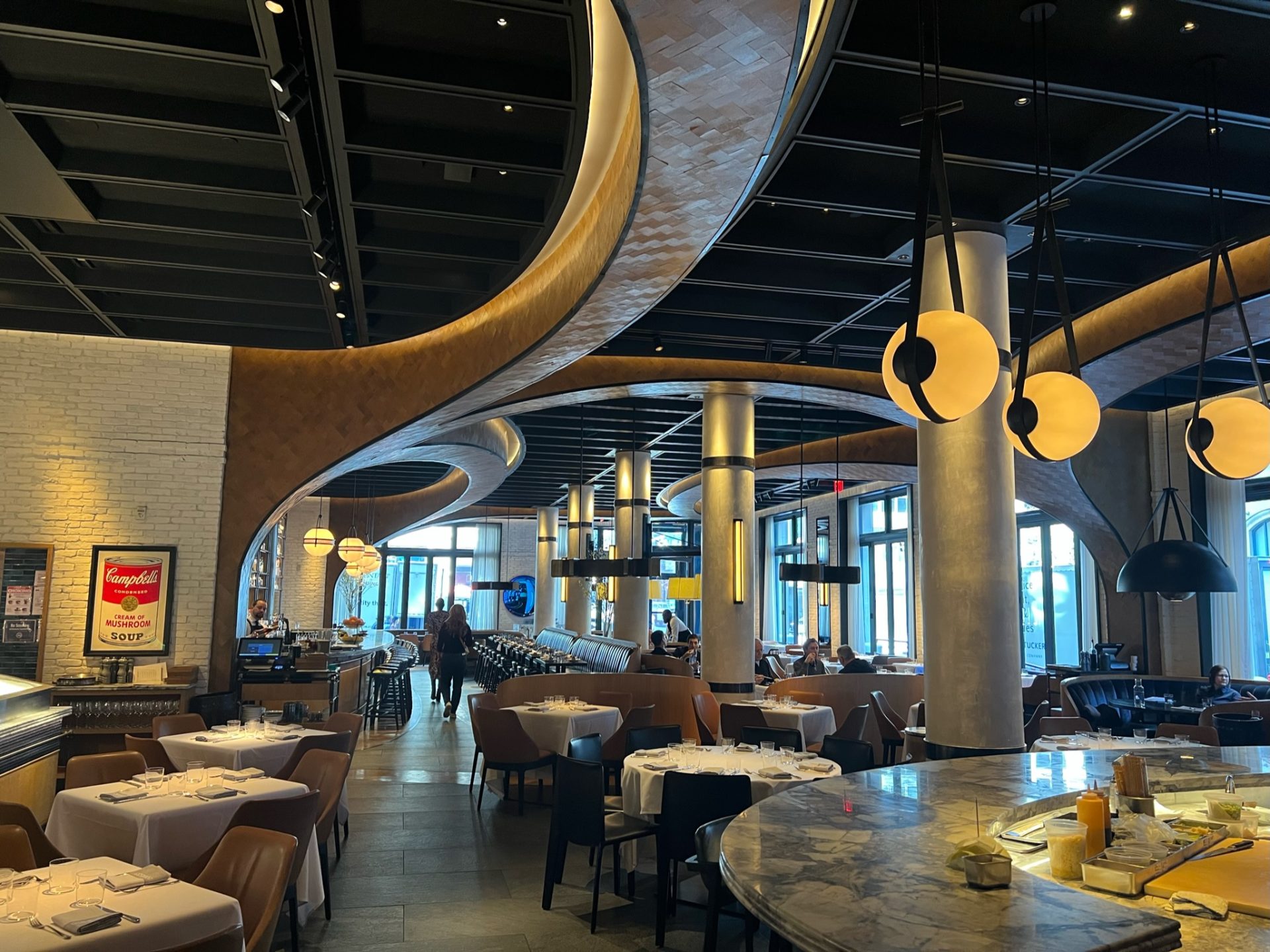Instagrammable Restaurants Islamabad: Picture-Perfect Dining Knowledge
Instagrammable Restaurants Islamabad: Picture-Perfect Dining Knowledge
Blog Article
Savor Authentic Eastern Cuisine With a Pan-Asian Spin for a Culinary Experience
Starting a cooking journey with authentic Eastern cuisine, enhanced with a Pan-Asian spin, provides a distinct opportunity to check out the rich tapestry of flavors that specify the region's diverse cooking practices. This experience invites you to appreciate the beautiful balance of preferences-- wonderful, salty, spicy, and sour-- harmonized by fragrant herbs and flavors. Imagine the cutting-edge blend of Thai curry and ramen or the unexpected pleasure of sushi burritos. As you consider these attracting meals, consider the cultural stories and historical impacts that shape them, each bite offering a tale waiting to be uncovered.

Checking Out Pan-Asian Flavors
In the realm of global gastronomy, Pan-Asian food sticks out for its impressive variety and the unified interplay of tastes from various Oriental cultures. This culinary strategy commemorates the abundant traditions and distinct ingredients located across the continent, developing a tapestry of tastes that is both interesting and rewarding. Trick to Pan-Asian cuisine is its ability to balance different flavors-- pleasant, salted, spicy, and sour-- while highlighting the freshness and top quality of each ingredient.
From the umami-rich soy sauce of Japan to the fiery chili peppers of Thailand, Pan-Asian food supplies an extensive scheme of tastes. These elements are commonly incorporated in inventive methods, enhancing meals with layers of intricacy. As an example, using aromatic herbs such as lemongrass and cilantro, common in Vietnamese and Thai cuisine, adds a rejuvenating brightness to meals, while the unification of coconut milk delivers a velvety, abundant structure.
The emphasis on fresh fruit and vegetables and fragrant flavors makes certain that each dish is not only a banquet for the taste buds yet also for the detects. Pan-Asian cuisine welcomes restaurants to begin on a cooking journey, checking out the vast and varied landscapes of Asian gastronomy with every bite.
Fusion Meals to Try
While Pan-Asian cuisine is commemorated for its traditional flavors, the modern culinary landscape is significantly accepting blend meals that blend these traditional aspects with influences from other areas. This cutting-edge method not only honors the rich heritage of Oriental cookeries yet likewise presents unique preference experiences that interest contemporary tastes.
A prime example of such a fusion meal is the Korean-Mexican taco, where marinaded bulgogi beef is covered in a warm tortilla, topped with kimchi and a spicy gochujang-infused salsa. This combination weds the strong, full-flavored flavors of Korea with the dynamic, fresh elements of Mexican cuisine. Similarly, sushi burritos have actually obtained popularity, amalgamating the delicate artistry of Japanese sushi with the hearty, hand-held convenience of a burrito, frequently featuring blend ingredients like tempura shrimp and avocado with a drizzle of wasabi mayo.
Another noteworthy meal is Thai curry ramen, which infuses the creamy, aromatic flavors of Thai curry into the soothing brew of traditional Japanese ramen, producing a harmonious mix that tantalizes the detects. These fusion dishes extend past simple uniqueness; they stand for a culinary discussion between cultures, motivating expedition and advancement worldwide of Pan-Asian food.
Necessary Active Ingredients and Spices
To really value Pan-Asian cuisine, one have to understand the vital active ingredients and flavors that create its foundation. This varied culinary style draws from an abundant tapestry of Oriental traditions, utilizing an unified mix of appearances and tastes. Trick active ingredients include soy sauce, fish sauce, and oyster sauce, which impart a tasty umami depth important to Oriental meals. Corresponding to these are rice vinegar and mirin, lending a fragile acidity and sweet taste.
Aromatic aspects are critical, with garlic, lemongrass, and ginger being common across different Pan-Asian recipes. These active ingredients supply a great smelling base that improves the intricacy of flavors. Flavors such as celebrity anise, cardamom, and cinnamon present warmth and personality, echoing influences from areas like China and India.

Cooking Methods and Tips
Mastering the art of Pan-Asian food requires experience with its unique food preparation strategies, each adding to the vivid tapestry of tastes this cooking practice is commemorated for. Central to these techniques is the stir-fry, a rapid cooking strategy that maintains the dietary honesty and vibrant shades of components. Making use of a wok, the stir-fry approach permits even heat circulation, necessary for accomplishing the characteristic appearance and taste balance of Pan-Asian recipes.
Another fundamental method is steaming, particularly common in Chinese cuisine. This gentle method keeps the natural flavors and nutrients of components, making it optimal for fish and shellfish and vegetables. Dumplings, a precious staple, commonly take hooters near me advantage of steaming, resulting in soft, succulent appearances.
Cooking, also essential, gives great smoky depths to dishes such as Korean bulgogi or Japanese yakitori (Best ambiance restaurants Islamabad). This technique typically involves marinading active ingredients, allowing flavors to penetrate deeply before food preparation over an open fire or hot plate
Finally, mastering the art of balancing tastes-- pleasant, sour, salted, bitter, and umami-- is crucial. Properly layering these components can raise a meal from regular to phenomenal, offering a complicated and pleasing culinary experience that personifies the essence of Pan-Asian cuisine.
Dining Experiences Worldwide
Across the globe, Pan-Asian cuisine supplies an unparalleled dining experience, celebrated for its abundant tapestry of flavors and dynamic presentations. This cooking phenomenon has actually gone beyond cultural boundaries, recording the hearts and tastes of food enthusiasts worldwide. In worldwide cities like New York, London, and Sydney, Pan-Asian restaurants work as melting pots where cooking customs from Thailand, Japan, China, and beyond merge, offering restaurants with an eclectic mix of meals that highlight the region's variety.
The international charm of Pan-Asian food lies in its ability to offer both credibility and development. Cooks skillfully marry traditional components such as lemongrass, soy sauce, and miso with modern techniques, leading to dishes that are both acquainted and refreshingly new. This combination enables diners to start a cooking journey that respects heritage while welcoming modernity.
Moreover, eating experiences are boosted through thoughtfully developed settings that mirror the ethos of Pan-Asian appearances. From minimal Japanese-inspired insides to lively Thai-themed areas, each dining establishment offers an unique setting that matches the cooking offerings. As an outcome, clients are not merely taking in a meal however partaking in a cultural experience, making Pan-Asian eating an absolutely global phenomenon.
Conclusion
The expedition of Pan-Asian food provides a profound understanding of the elaborate interplay of tastes and cooking practices throughout Asia. By welcoming combination dishes such as Thai curry ramen and sushi burritos, the culinary journey not just highlights the adaptability of conventional components yet also showcases innovative modern-day methods. This gastronomic adventure, enriched by necessary spices and cooking approaches, offers a distinct chance to appreciate the multiculturalism and culinary creativity that define Pan-Asian cuisine on a worldwide range.
Getting started on a cooking journey through genuine Asian cuisine, improved with a Pan-Asian twist, supplies an unique possibility to explore the abundant tapestry of tastes that define the region's varied culinary practices.In the realm of worldwide gastronomy, Pan-Asian cuisine stands out for its good food near me exceptional variety and the unified interaction of flavors from numerous Asian societies. Trick to Pan-Asian cuisine is its capability to balance contrasting tastes-- wonderful, salty, spicy, and sour-- while highlighting the quality and high quality of each ingredient.

Report this page